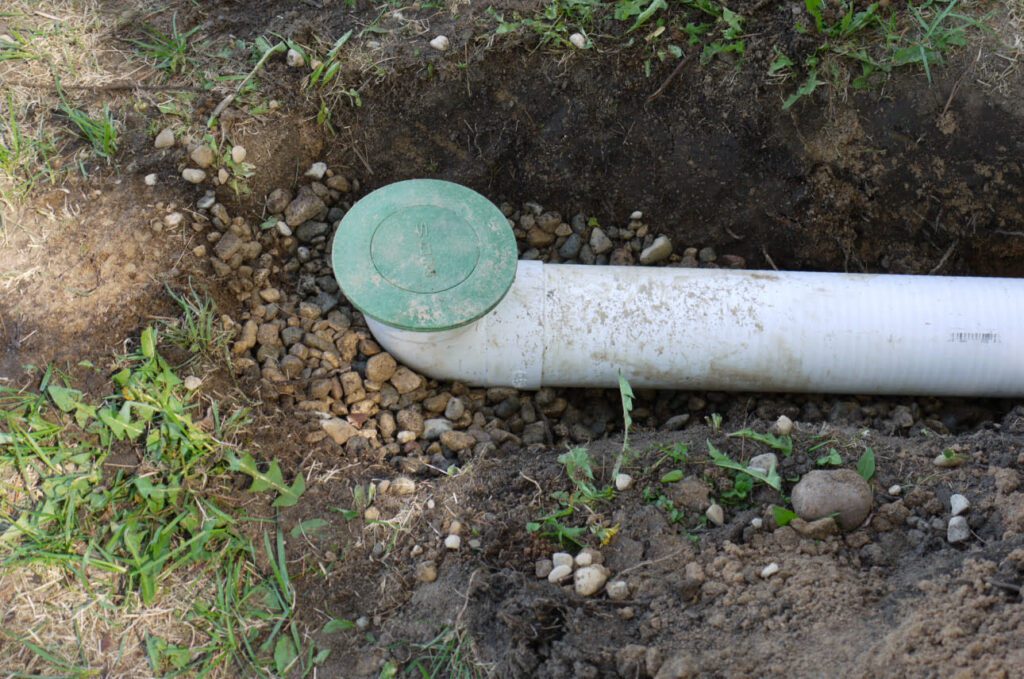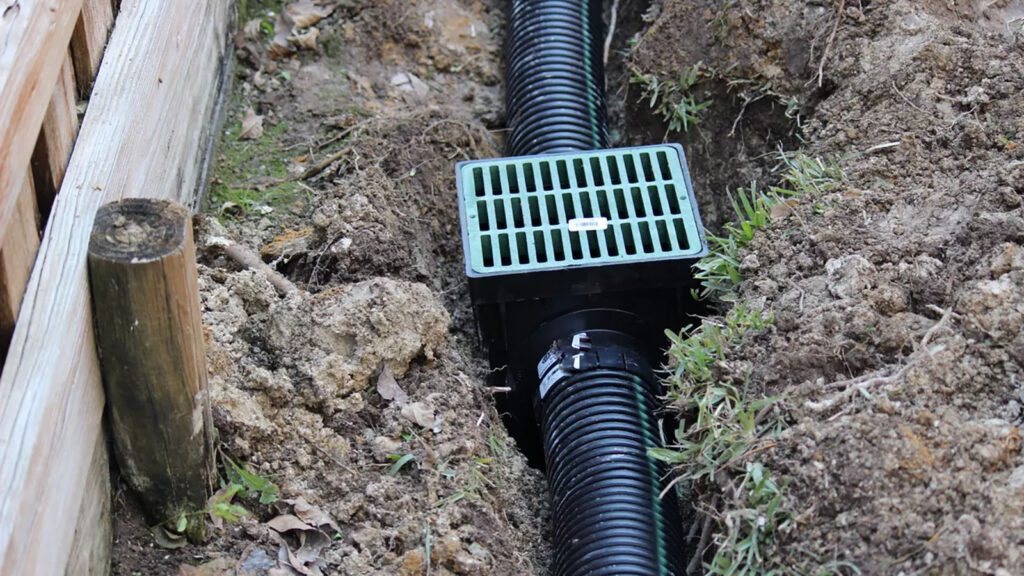How to End a French Drain – Tips for Home Drainage Fixes
How you finish a French drain makes a huge difference in how well it performs. If done wrong, you risk backups, erosion, and even foundation problems.
In this guide, we’ll walk you through simple, effective ways to wrap up your French drain properly—so water flows out, not back in.
How to End a French Drain Properly
To end a French drain properly, direct runoff to a dry well, pop-up emitter, or daylight outlet with clear flow and drainage support.
Key Takeaways
- A properly finished French drain prevents backups, erosion, and foundation damage.
- Common termination options include pop-up emitters, dry wells, daylight exits, rain gardens, and gravel pits.
- Your yard’s slope, soil, space, and local codes all influence the best end solution.
- Don’t block the drain’s exit or direct it toward neighboring properties.
- Regular maintenance like clearing debris and checking slope is essential.
What Does It Mean to ‘End’ a French Drain?

Ending a French drain isn’t just about where it stops—it’s about where the water goes next.
You need to decide what to do with the runoff: send it to a dry well, pop-up emitter, gravel pit, or even out to the street (if your city allows it).
If you get this part wrong, you’re just moving the problem elsewhere. That could mean soaked lawns, structural issues, or unhappy neighbors. The endpoint matters.
Common Options to End a French Drain
1. Pop-Up Emitter
A popular choice. Water flows underground and releases through a green cap when pressure builds. Great for sloped yards and easy on your lawn’s look.
2. Dry Well
A dry well holds runoff and slowly releases it into the ground. Ideal for flat yards without a slope or ditch for drainage.
3. Daylight Exit
If your yard slopes downhill, a daylight exit is simple and low-maintenance. Just make sure it drains somewhere legal and away from your neighbor’s backyard.
4. Rain Garden
Want to flex your eco-side? A rain garden grabs runoff and turns it into a plant party. It filters water naturally and looks way better than a soggy patch of grass.
5. Gravel Pit
Low on space or just want something that disappears into the background? A gravel pit handles overflow fast. It’s like the French drain’s silent partner—no fuss, all function.
Bottom line: pick the finish that matches your yard and lifestyle. French drains aren’t just about function—they’re about keeping things cool above ground, too.
How to Choose the Best Termination Method
1. Know your backyard’s vibe
Before locking in a drain ending, check your slope, soil, and space. A steep yard? Dry well might be the move. Flat and soggy? Pop-up emitter’s your cheat code.
2. Think about where that water’s going
Your French drain’s got one job: ditch the water, not dump it on your neighbor’s lawn. Aim for a safe outlet—street, swale, or a drain basin that can handle the flow.
3. Keep maintenance in mind
Some options are set-it-and-forget-it. Others? You’ll be digging them up every season. Pick one that fits how much upkeep you’re cool with.
4. Play it by the rules
Don’t skip the boring stuff. Local codes and HOA rules can shut your whole project down. A quick check now saves major headaches later.
5. Match it to your setup
No two yards are built the same. The best choice is the one that actually fits your layout, not just what looks good in a YouTube tutorial.
Steps to Properly End a French Drain

1. Figure out where the water’s going
Don’t just guess—decide if you’re sending water to a dry well, drainage ditch, or safe runoff area. This choice sets the whole tone for the end of your drain.
2. Create a solid exit
If you’re using a pop-up emitter, make sure it sits slightly above the ground so water flows out, not back in. Going with a dry well? Dig deep enough for gravel and a fabric liner to keep things clean.
3. Add a drainage outlet that actually works
You want water out, not pooling around. Use perforated pipe and gravel if you’re draining into a pit, or a smooth solid pipe if it’s heading to the street.
4. Top it off the right way
Cover your exit with a grate, river rocks, or mulch—whatever fits your style and keeps things from clogging. Bonus: it’ll blend in better with your yard.
5. Double-check the slope
Water won’t flow if the slope’s off. Quick level check now saves you a soggy headache later. Simple moves, big difference. Get the finish right, and your French drain won’t just work—it’ll flex like a pro.
Common Mistakes to Avoid When Ending a French Drain
1. Stopping the Drain Too Early
Cutting the system short is like texting your crush and ghosting halfway through. If your drain doesn’t lead far enough downhill, water just pools—right where you didn’t want it.
2. No Gravel or Outlet Support
Skipping gravel at the end? That’s asking for a soggy disaster. Without it, water seeps into soft soil, messing up your yard’s vibe.
3. Pointing It at a Neighbor’s Yard
Not cool. Your runoff becomes their problem, and suddenly you’re the villain in a backyard soap opera. Redirect water to a safe, legal spot—like a dry well or drainage ditch.
4. Covering the Exit
Don’t trap the water. Covering the end with dirt or mulch is like putting a cork in a bottle—it backs up fast. Keep it clear and flowing.
Maintenance Tips for Your Drain Exit Point

Don’t sleep on your drain’s exit point—it’s the last stop before water peace or puddle chaos. Every couple of months, do a quick check. Make sure nothing’s blocking the flow: leaves, mud, rogue tennis balls—whatever life throws at it.
If the pipe drains into gravel, clear off any buildup. Got a pop-up emitter? Make sure it still pops and doesn’t stick shut. And if your yard floods after a storm, your outlet might need a longer extension or a better slope. Keep it clean, keep it clear, and your French drain will stay in chill mode.
Frequently Asked Questions
1. How should I end a French drain?
Cap it with a dry well, pop-up emitter, or daylight outlet. Just don’t let it dead-end underground with nowhere to drain.
2. Can I connect a French drain to the sewer line?
Nope. That’s a fast track to a backed-up mess. Stick with stormwater-safe exits only.
3. Does the end need gravel too?
Yep, keep gravel around the outlet. It helps with drainage and keeps soil from clogging things up.
4. What if water’s still pooling?
Check the slope. If it’s not angled right, it’s just a trench party with no exit.
Conclusion
A French drain isn’t just about digging a trench and tossing in gravel. How you end it matters.
Cap it with a dry well, pop-up emitter, or daylight exit—whatever fits your setup best.
The goal? Keep water flowing out, not backing up or hanging around.
Play it smart, stay low-key with the install, and you’ll save yourself a ton of cleanup later.
That’s the cheat code to a drain that actually does its job.
